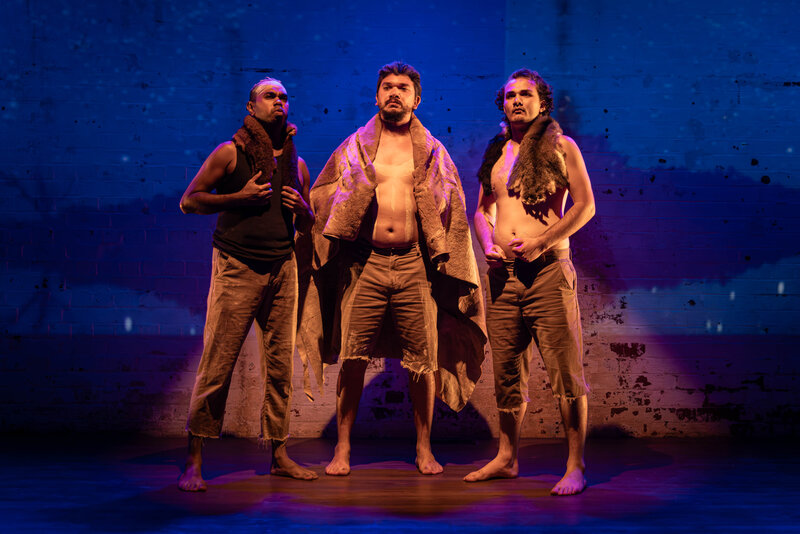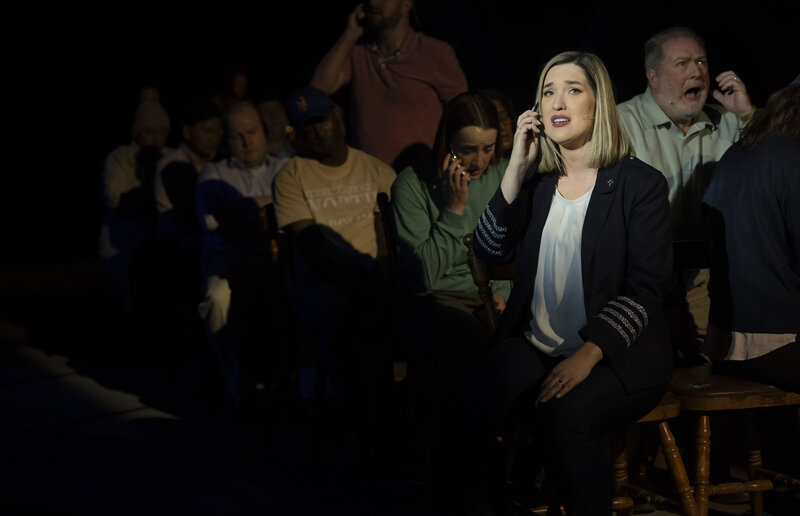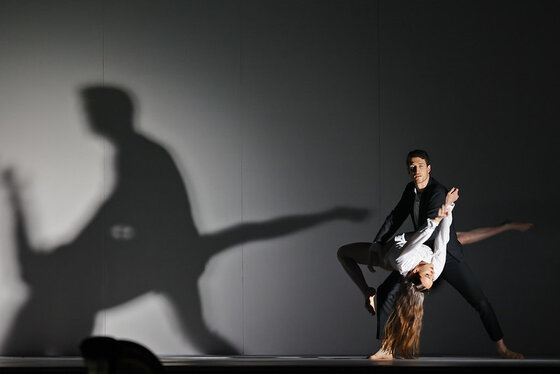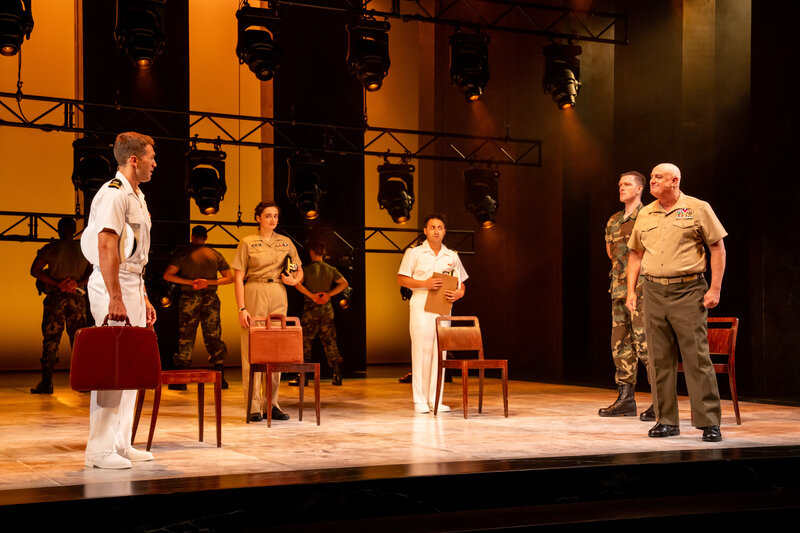The Golden Age, by Louis Nowra was published in 1985. The first production was given at the Playbox Theatre in Melbourne, Directed by Rex Cramphorn. I first saw the play in a NIDA production by Neil Armfield with Richard Roxburgh, as Francis – it was a truly memorable production.
I have had, always, a ‘romance’ about the early work of Louis Nowra. In the late 1970’s a group of artists, including myself, had taken the Lunchtime Theatre, the Q Theatre, out to Penrith and began a full time theatre company. To do that, as ‘core’ members of the company, we gave-up our agents and practiced exclusively in the Western outskirts of Sydney, to establish that company without the ‘temptation’ of the profession to distract us (mostly based in Sydney).
 Part of that ‘temptation’ for me was the work of Louis Nowra: his first play was Inner Voices (1977) and it concerned the son of Catherine the Great who had been imprisoned without real connection to the world. Visions (1979) set in South American jungles, in the past, during the overthrow of a tyrannical government. Then, a trio of French stories, a translation/adaptation of Dumas fils’ The Lady of the Camellias (1979), Beauty and the Beast (1980), and Cyrano de Bergerac (1980). There followed an adaptation of Wedekind’s Lulu (1981), The Precious Woman (1981) – a play set in the nineteen-twenties during upheavals led by competing war lord’s in China – and his first Australian setting Inside the Island (1981). My romance was built about this consistent Australian writer who wrote plays set outside Australia and not just in ‘domestic’ Australian culture – an Australian writer with an international ‘setting’ vision, one not, relievedly, in the Australian bedroom,or ‘bar room’! – a positive rarity.
Part of that ‘temptation’ for me was the work of Louis Nowra: his first play was Inner Voices (1977) and it concerned the son of Catherine the Great who had been imprisoned without real connection to the world. Visions (1979) set in South American jungles, in the past, during the overthrow of a tyrannical government. Then, a trio of French stories, a translation/adaptation of Dumas fils’ The Lady of the Camellias (1979), Beauty and the Beast (1980), and Cyrano de Bergerac (1980). There followed an adaptation of Wedekind’s Lulu (1981), The Precious Woman (1981) – a play set in the nineteen-twenties during upheavals led by competing war lord’s in China – and his first Australian setting Inside the Island (1981). My romance was built about this consistent Australian writer who wrote plays set outside Australia and not just in ‘domestic’ Australian culture – an Australian writer with an international ‘setting’ vision, one not, relievedly, in the Australian bedroom,or ‘bar room’! – a positive rarity.
The Golden Age, in 1985, embraced a genre of Australian Literature: the Tasmanian Gothic, in this case the finding of the remnants of a lost group of white settlers in the wilds of Tasmania, with a derivative language and ‘culture’ all their own, in a degenerative biological state, who are forced to re-engage with civilisation and, consequently, die-out under medical supervision. The connections and paralleling to the International War of 1939-45, and some of the ‘policies’ of the Nazi regime, gave the play a metaphorical dimension that was striking to myself, in those long ago days of my relative naivety of the History and Behaviour of our species. Too, the literary references to The Greeks with a rehearsal of Euripides’ Iphigenia in Tauris, opening the play, and a presentation of a King Lear (Leir), by the lost ‘tribe’ with a happy ending, also gave it, for me, allure – romance. This play had all the thematics of Nowra’s fascination with the ‘underdog’, the ‘cheated’, of our civilisations and was disturbingly (1985) subversive.
For me, Louis Nowra lost his edge when he began writing semi-autobiographical plays such as Summer of the Aliens (1992) and Cosi (1992). He became less interesting and more like the ‘pack’.
So, it was with much anticipation and expectation that I attended the Sydney Theatre Company’s (STC) production, by Kip Williams, of this play. I do believe Sydney has seen this play professionally before – Nimrod or Belvoir? Who directed it? Who was in it? I can find no reference to it – and the Sydney critic’s have been delighted, all-round, with the finding of this, in their words, this Great Australian play! Not seen for some 32 years!
I am an admirer of the directorial potential of Mr William’s but have often found his very visual approach, distracting to the clarity of the writer’s text. This production of The Golden Age, however, for me, was, at last, a synthesis of his own visual proclivities with the original text on the page. This is a fairly accurate textual rendition of Mr Nowra’s gift, enhanced with the beauty of Mr William’s eye for picturesque imagery. The set design, by David Fleischer, which consists, originally, simply of a heaped hill of dirt, in a surround of white washed walls, is transformed in the action of the play, to stimulate the imagination of the audience throughout the action of this near three hour play, with selected details – e.g. the placements of ‘spears of steel’ over its horizon to form the ‘hospital/prison’ of the ‘tribe’ – and is gorgeously, brilliantly, lit by Damien Cooper to create for us a world of visual splendours that epitomise and emphasise, for us, the tragedy of the story. The play consists of many, many short scenes and they could be a derailing, destabilising influence to the kinetic forward movement of the story, but Mr William’s has found in the sound composition and sound design of Max Lyandvert a beautiful and enveloping surround that holds the play and its complexities in an embrace that aurally bridges the sensations of the scenes into a smooth and containing arc of experience. This score by Mr Lyandvert is startling in its conception and execution.
 As in the original plan of the writer, nine actors, in this case – Rarriwuy Hick, Remy Hii, Brandon McClelland, Robert Menzies, Liam Nunan, Zindzi Okenyo, Sarah Pierse, Anthony Taufa, Ursula Yovich – play all 18 roles, some with intricate and swift costume changes. The company of actors are from diverse cultural backgrounds (representing the multi-cultural possibilities in casting, at last, in Sydney) and may, for some audience members provide, at first, a confusion of identification of who is who and how are they connected. For some, an adjustment of the simple usual visual perception will require an ‘intellectual’ energy to, for instance, grasp that Ms Yovich, an Australian Indigenous actor, is creating the white ‘aristocratic’ matriarch of the Hobart society, Elizabeth Archer, and that Mr Hii, is her ‘aristocratic’ son, Peter Archer, whose father, William Archer, is played by Robert Menzies. But, sometimes, this cross cultural casting can create wonderful and arresting identifications of metaphoric resonances, particularly, say in the casting of Ms Hick, an Australian Indigenous actor, as Betsheb, a white survivor of the ‘tribe’.
As in the original plan of the writer, nine actors, in this case – Rarriwuy Hick, Remy Hii, Brandon McClelland, Robert Menzies, Liam Nunan, Zindzi Okenyo, Sarah Pierse, Anthony Taufa, Ursula Yovich – play all 18 roles, some with intricate and swift costume changes. The company of actors are from diverse cultural backgrounds (representing the multi-cultural possibilities in casting, at last, in Sydney) and may, for some audience members provide, at first, a confusion of identification of who is who and how are they connected. For some, an adjustment of the simple usual visual perception will require an ‘intellectual’ energy to, for instance, grasp that Ms Yovich, an Australian Indigenous actor, is creating the white ‘aristocratic’ matriarch of the Hobart society, Elizabeth Archer, and that Mr Hii, is her ‘aristocratic’ son, Peter Archer, whose father, William Archer, is played by Robert Menzies. But, sometimes, this cross cultural casting can create wonderful and arresting identifications of metaphoric resonances, particularly, say in the casting of Ms Hick, an Australian Indigenous actor, as Betsheb, a white survivor of the ‘tribe’.
All the company give focused and concentrated performances, some more successful at one role over another. Ms Hicks gives an outstanding performance as Betsheb, so does Mr McClelland as the working class, bridge engineer, Francis. Mr Nunan, as the disabled Stef is remarkable in the ‘twisted’ physical conjuring of this life-force, whilst Ms Peirse, as “Queenie” Ayre, the leader of this lost tribe, signals her abilities as an actor, especially when one casts one’s mind back to her last performance in Sydney, as Patricia Highsmith, in Switzerland. Mr Menzies in the dual role of Dr. William Archer and then, Melorne, senior male of the lost tribe, too, demonstrates his versatility.
The affect of this production and all of its elements engages one with the pre-occupations of Louis Nowra with a clarity and strange beauty that deserves the attention of the Sydney audiences. It will cause some conversation and debate, not least, sometimes, about a kind of underdeveloped thematic eloquence in the writing itself. But it is the scope and striving artistic vision that Mr Nowra sought in the 1980’s Australia that at last can be appreciated for its daring and courage. This production, by Kip Williams, serves the writer well. It is a good play if not a great one. It is definitely a great production of a neglected Australian play. And, there are many more out there, I suspect. Good plays lost by bad production. Name some others.
Do see.
P.S. By coincidence, last year, I visited the Greek Temple built by Lady Franklin, the wife of one of Tasmania’s early Governors, in what then may have been the ‘bush’ edges of Hobart city – fascinating – now used, occasionally as an Art exhibition space. I thought of Mrs Archer and her theatre enterprises, and had photographs taken of me as a ‘blinded’ Oedipus making an entrance through the columned portico!
N.B. I have a personal aspiration to see, what I think is the best of these plays by Mr Nowra, The Precious Woman, set in China, played by an Australian/Asian company of actors. I think it is time. I’ll do it, if no-one else will! I know that I can cast it. I have a dream! Ha, ha.
Company: Sydney Theatre Company
Venue: Wharf 1 Thearte, Hickson Rd, Walsh Bay, Sydney
Dates: to 20 February 2016
Kevin Jackson
For more of Kevin Jackson’s theatre reviews, check out his blog at Kevin Jackson’s Theatre Diary

David Edwards is the former editor of The Blurb and a contributor on film and television




